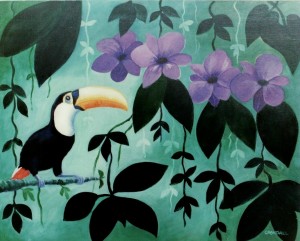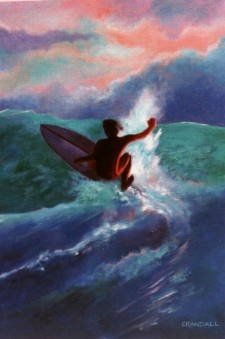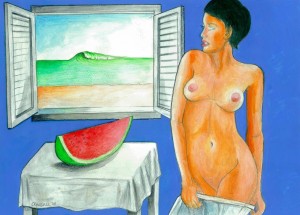Gary Crandall Paipo Interview
November 22, 2009. Highland Village, Texas (USA)
Questions and e-Mail Interview by Bob Green
Photos courtesy of Gary Crandall
1. Why did you start riding a bellyboard?
Had
tried a regular surfboard, but always liked the feel of acceleration
through hot curl most of all. All the histrionics on a wave… up and
down, back and forth… was just a bunch of chewing gum. Give me a
straight shot of Cuervo! And unless you’re riding the Pipeline you’re
not inside the curl. A bellyboard is down and dirty with the wave…
inside the curl even on smaller waves. And the sense of speed is
greater just inches from the water. Feeling the salt spray peppering
your face is pure joy.
There was a guy named Bob Haworth (as I recall), who hung out at a
local surf shop in Goleta, California (adjacent to Santa Barbara). He
had built his own paipo board and was kind of an underground legend
around the area. He surfed all the spots from Hollister Ranch north of
Santa Barbara to Rincon and Ventura. Tall, lanky guy. He was a regular
dolphin in the water. Watching him made me want to try bellyboarding.
2. When was this?
1964… early in the surfing evolution.
|
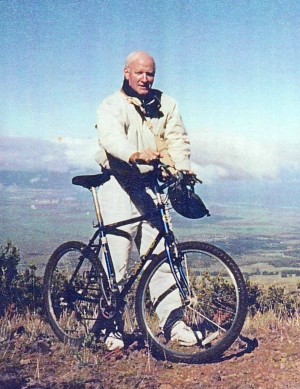
Bike ride down Mt. Haleakala - Maui - ca. 1998
|
3. Tell me about the board you named ‘L’Enfant Terrible.’ Where did you get the design from? What were the dimensions and construction method?
I
got the design from the guy mentioned above, Bob Haworth. Definitely a pioneer in bellyboarding. It was homemade out of marine ply about
5/8ths of an inch thick. Approximately 4 feet long, 2 feet wide. The
skeg was in the center of the board where the weight of the body was
balanced. Just a slight shift of body weight gave the skeg good bite in
the water when cranking out turns.
I added a little panache to it by painting my own design (a Tasmanian devil sort of creature) on it. Called the board L'Enfant Terrible, and gave the whole thing a coat of resin.
This is around 1965 before the commercial styrofoam Boogie Boards hit
the market. Although you can see from the article there were some sleek
paipo and kneeboard designs beginning to emerge at the time.
4. Where did you get the idea to place the fin in the centre of the board? What benefit did this fin set up have?
The
idea came from the board used by Haworth. He used one like it to great
effect. It made sense. The center of the board was where the body’s
center of gravity was. It pivoted very smoothly. Although it might be
interesting… hydrodynamically… to compare it to a rear-placed skeg or
dual skegs if it hasn’t already been done.
|
5. Was ‘L’Enfant Terrible’ your first bellyboard? If not, can you tell me about your earlier boards? What were they like and did you make them?
Yes, L’Enfant Terrible
was my first bellyboard. And the best of the lot. I made two others
like it. One in 1977 (see photo to the right), but it didn’t seem to
perform as well. Possibly because this was in Redondo Beach shorebreak,
not good point break as in Santa Barbara.
6. Did you make or have any other boards made for you after ‘L’Enfant Terrible’
I
had a comical experience in Brazil along those lines. I wanted to try
the surf there so went to a local carpenter with a sketch. He got the
dimensions right, but instead of marine ply he made it out of a local
wood called jacaranda. It’s very hard and very heavy. The board
barely floated. I tried it at a coastal town named Ubatuba. The surf
was pretty lousy, but the locals got a chuckle watching me wrestling
that thing onto buses looming out of my backpack.
7. What sort of waves did your boards go best in?
Point
break was always the best… especially in hot, fast curl. A quick ride
down the tube of a shorebreak cruncher was also lots of fun. Still
shaking the water… and sand… out of my ears.
|
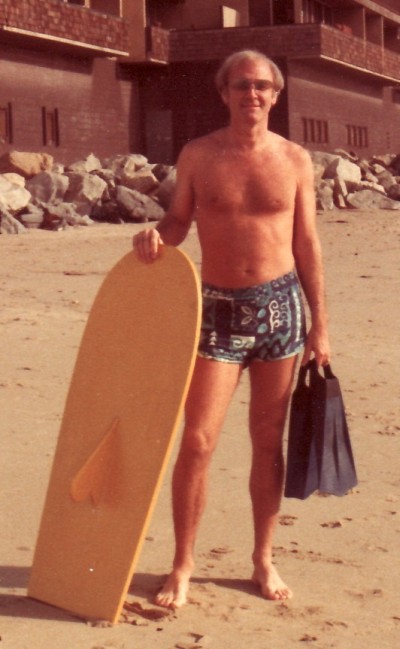
|
8. What was your style of surfing? Any particular techniques that you used to turn or gain speed?
I
was there for the speed, not the aerobatics. My left hand was on the
front of the board for steering. My right hand thrust out ahead of me
for balance. I shifted body weight for turns and finding the “sweet
spot” in the wave. Lifted my legs to reduce drag.
Although this style board was a sweet ride once in the wave, getting
into the wave took a lot of power kicking and reading the waves right.
Lighter weight Boogie Boards will pick up waves easier. My plywood
board was fairly inert, so I had to be the engine.
9. Did you always ride prone or did you knee-ride as well?
Always
prone… not a good board for knee-riding. But my main objective was to
be down as close to the water as possible. I wanted that feeling of
intimacy.
10. Where did you surf mostly? Did you travel much?
Another
guy and I used to go down to Campus Point at the University of
California, Santa Barbara a lot in those days. There was a student
community called Isla Vista right on the beach where we lived. Major
party town. 10,000 students packed into a half a square mile. Between
surfing and partying there was a high attrition rate at that university!
There was a nice point break there. But I've used the bellyboard at
many places up and down the California coast… Rincon, El Capitan,
Jalama, Hammond’s Reef, County Line, Dana Point (before they put in a
yacht harbor there it was known as "Killer Dana"), Laguna Beach, and
other spots. Maui, Brazil.
One drawback to surfing the more popular spots was that the standard
surfboards could get up and into the wave faster than a
bellyboard. And they didn’t have any qualms about “dusting” you
with their board… usually with an expletive or two… if you got in the
way. The Code of the Sea didn’t apply. In fact, I think they delighted
in it. Bellyboarders are definitely 2nd Class citizens at the major
spots.
Wave Riding at Campus Point - Santa Barbara, California - ca. 1965
|
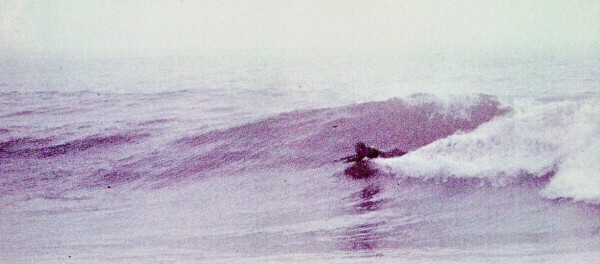
|
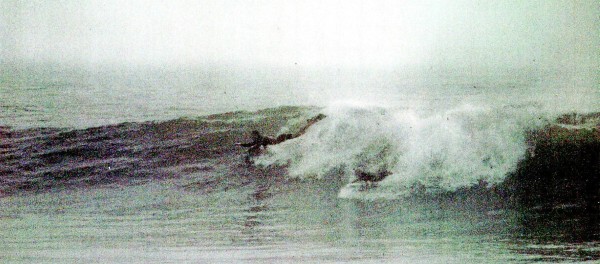
|
|
11. Did you see many bellyboarders in the local area or on your travels? If so, what sort of boards were they using?
At
that time, very few. Mostly standard surfboards and surfers. Later the
Morey Boogie Boarders hit the beach in droves. Mostly amateurs, but a
few surfaced who could really wire the waves.
12. What was it like surfing Dana Point on a bellyboard?
Scary.
Dana Point got some really hairy waves rolling through in the old days.
Big and mean. I remember wiping out and being caught inside one time. I
kept surfacing for air, but the waves broke so hard there was several
feet of foam on the surface. I couldn’t get all the way to the top.
Could have been a goner that day. Makes you a believer and respect the
power of waves.
13. Any surfs or waves stand out from the others?
I
always enjoyed Campus Point next to the University of California,
Santa Barbara. My buddy and I would ride down there on bicycles. We
could take off out by the rocks where regular surfers didn’t go. That
allowed a hot, fast ride before the wave built up again into a longer,
slower line-up that swept down the beach.
Also, Rincon. A classic place. Beautiful long rides with predictable line-ups.
14. What was the attraction of bellyboarding for you?
Intimacy
with the ocean. The sense of speed. Matching wits with a capricious
force of nature. An absence of rules. The heady scent of salt
air. Beach fires. Warm sun and wetness on bare skin. The minimalism of
the sport. No clunky paraphernalia required. Fresh air. The adrenaline
rush. Every wave is different. The sense of timelessness about waves
that have been travelling for thousands of miles and crashing on shores
for millions of years. It’s not better than sex… but it’s a close
second.
15. Was there much reaction to the article you wrote in Surfer? What was the background to writing the article? [See Note 1.]
Don’t
remember much reaction. I wrote it as a paean to the sport I loved. A
free-lance article I submitted totally on spec. But, serendipitously,
they had some other pieces in the slush pile and they liked mine as a
sort of mood-setter introduction because I tried to capture the poetry
and sensations of the bellyboarding experience.
16. You are in Texas now. When did you last regularly ride your bellyboard?
Texas
is flat as a fritter. Not much surf. Haven’t done much regular surfing
since the 1980s. Only an occasional Boogie Board fling in Hawaii,
Cancun, Cape Hatteras on the Carolina coast.
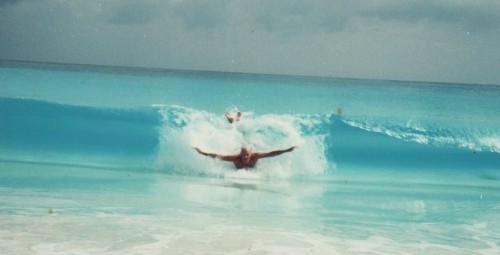
Bodysurfing in Cancun, Mexico - ca. 1994
|
Cancun, Mexico - ca. 1994
|
17. Any other comments about bellyboarding or surfing?
If
the earth were to shift three degrees, all the plankton would shift
three degrees. All the birds in the sky would shift three degrees. All
the leaves of the forest would shift three degrees. But the guy
speeding down the freeway in the air-conditioned behemoth dripping with
chrome wouldn’t have a clue… and would go sailing off the nearest
precipice. Because, as human beings, we aren’t paying attention.
So many people are dead from the waist down. We have lost touch with
instinct. We have lost touch with ourselves. We have lost touch with
that million-year-old creature at the base of our spine.
That is why I like surfing.
It cleanses the cobwebs accumulated by our landlocked existence… all
the rubble of false rituals and oppressive rules. The sea is always up
to its old tricks. You have to stay alert. You have to pay attention.
Out here every fish, every bird, and every piece of flotsam is on its
own. No favors asked. No quarter given. A billion years rise up on the
crest of each wave. And there’s an ornate happiness in being immersed
in all that time… and all that liquid.
“Civilization is falling from me little by little,” said Paul Gauguin as he rediscovered his instinctual self in Tahiti.
To me, this is where it matters. This is what bellyboarding has given
me. In the voluptuous barbarity of the waves. An awakening of the
senses… the muscles… the molecular energy of movement. In things that
can be touched and felt. Things that jolt the emotions… where the
sparks fly… an awareness of what it means to be alive. Where you can
hear the gleeful howls of the inmates escaping from the asylum.
This is Cosmos 101. The Classroom of the Waves. From here on in our
directions come straight from the universe. And there is something
about it… in those inconsequential moments of surfing… that aspires to
the beautiful soul.
|
|
Note 1. Gary's article, Potato Chip Thrills In a Washing Machine, was part one in the small trilogy, "Toward Unencumbered Flight," in Surfer Magazine, 11(2). PDF [6.5MB].
|
|






